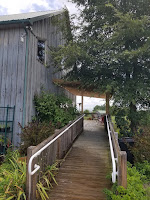Navarra’s reputation for making exceptional wine blossomed during the late Middle Ages, as pilgrims traveling along the Camino de Santiago—a medieval pilgrimage route currently enjoying a dramatic resurgence in popularity—began noting the particularly high quality of wines they encountered as they made their way through the Kingdom of Navarra, en route to the shrine of St. James the Apostle in Santiago de Compostela, roughly 400 walking miles to the west, in the northwestern Spanish province of Galicia. (Rioja, Navarra’s next-door neighbor to the west, found its own early fame in precisely the same way.) -- Navarra Wine
Navarra is not only the convergence of Camino de Santiago pilgrims and traded between the Iberian Peninsula and the rest of Europe, but also a "rugged, transitional zone at the convergence of three major climate types–Mediterranean, Continental, and Atlantic". This results from its proximity to the Bay of Biscay (Atlantic Ocean) to the northwest, the Pyrenees to the northeast, and the Ebro River -- all combine to moderate the temperatures within the inherent Mediterranean climate. This convergence helps create a diverse landscape comprising a semi-desert basin, lush woodland hills, and high mountain peaks, all within a total area smaller than that of Connecticut.
The D.O. Navarra wine region occupies roughly half the area of the municipal region of Navarra, with approximately 11,500 hectares of vineyards. The D.O. is bounded to the north by the verdant lower slopes of the Pyrenees, just below Pamplona, and extends southward and outward, down a series of river valleys until the region reaches its southern terminus at the arid Ebro basin. Because of its geographic and climatic diversity, five sub-zones were created: Baja Montana in the northeast, Valdizarbe in the north, Tierra Estella in the northeast, Ribera Alta in the center, north of the Ebro, and Ribera Baja in the south below the river. A small section of Navarra is classified as Rioja DOCa (Denominación de Origen Calificada)".Ribera Alta is situated along Navarra’s midsection -- a transitional belt between the semi-arid south and the dry north -- with a large concentration of wine-growing centered around the historical town of Olite. Many of the 4,125 hectares of vines are planted along the gentle slopes leading to the River Ega. Far from the influences of the Atlantic and the Pyrenees, Ribera Alta is typically warmer than its three neighboring subzones to the north. It contains a mixture of soils, depending on elevation and substrata composition. On most slopes, soil depth and particle size vary, with layers of fine or silty loam alternating with marl and sand. There are exceptions where vineyards sit atop shallow, loamy-clay soils with marked calcareous content.
 |
| Photo Courtesy of Bodegas Alconde |
Although Graciano is considered indigenous to Navarre, it is considered a minor grape with less than 2% of D.O. Navarra plantings. Perhaps because this variety is susceptible to mildew and very low-yielding. Wines made from Graciano have moderate tannins and an intense aroma that makes the variety very popular with winemakers to use in the classic Rioja blend with Tempranillo and Garnacha.
However, just to the west of Olite, in Lerín, Bodegas Alconde produces a single-varietal Bodegas Alconde Graciano X01 (14%). Viticulture in Lerin is at least as old as the Roman era as evident by the wine artifacts found at the Roman villa at Arellano. Later in medieval times, there is documented evidence of the wine trade between Navarre and the Basque Country and La Rioja written in the La Saca of 1356 -- "a document which, by order of the Crown of Navarre, contained the records of this national export of the wine produced in the town".According to Bodegas Alconde, "we bring together the whole tradition of winemaking that dates back to Roman times. We are local winegrowers, we are from here, we are Lerineses and we have been growing vines and making wine for many, many generations. In fact, we don’t even know from when because it is not documented. We only know that our grandparents, our grandparents’ grandparents, and their grandparents… all made wine".In fact, Bodegas Alconde was created in 1956 as a collective of several small family winemakers who learned their craft directly from techniques passed from previous generations. They combined their vineyards -- 150 hectares of vineyards and all at least 50 years old and sometimes over a century old -- with the shared goal to create quality Ribera Alta wines. The vineyards around Lerin experience old winters and hot summers and are planted in poor and limy soils that are suitable for small yields. The grapes for the Bodegas Alconde Graciano X01 come from such a low-yield plot. The wine is immediately impactful from its strong floral aroma which yields to bright silky cherries and a structured soft finish. Excellent.
Maps courtesy of Navarra Wine.














































